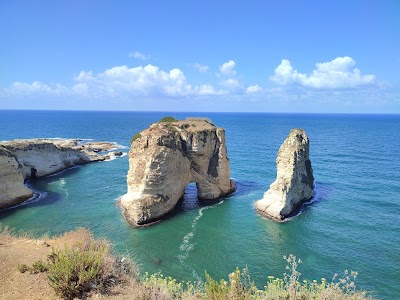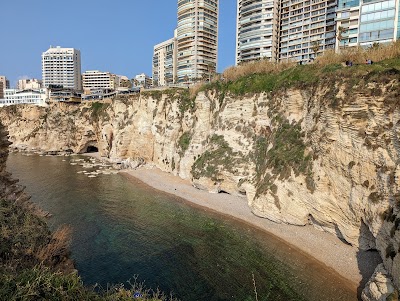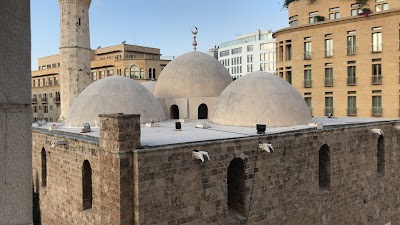Pigeon Rocks (صخور الحمام)
Overview
Pigeon Rocks: A Natural Icon of Beirut
Pigeon Rocks, also known as Raouché Rocks, are among the most iconic natural landmarks of Beirut. Rising majestically off the coast of the Raouché district, these stunning limestone formations offer breathtaking coastal views and are surrounded by a vibrant neighborhood filled with upscale restaurants and cafes. The area attracts both tourists and locals alike, making it a must-visit destination when exploring the city.
The fascinating history of the Pigeon Rocks dates back to ancient geological times, shaped by the relentless waves of the Mediterranean Sea over millennia. These towering formations not only symbolize the natural beauty of Beirut but also serve as a testament to the region's geological history. Their impressive size and distinctive shapes, particularly the larger rock with its striking arch, create a captivating seascape that has intrigued visitors for generations. The magical moments during sunrise and sunset, when the light dances off the rocks and water, make for unforgettable photographs.
Local lore adds to the allure of the Pigeon Rocks. Legend has it that these formations are remnants of a titan who once attempted to conquer Beirut. The name "Pigeon Rocks" is believed to derive from the Latin word “Petra,” meaning rock, which eventually evolved into "Pigeon" in English. Alternatively, the name may reflect the local wildlife, as flocks of pigeons frequently inhabit the area, making it a delightful spot for birdwatchers.
For those seeking adventure, boat tours around the Pigeon Rocks offer a closer look at their grandeur, complete with interesting anecdotes and historical snippets from local operators. If you prefer to stay on solid ground, the nearby coastal promenade provides numerous vantage points for stunning views and perfect photo opportunities, allowing you to soak in the serene beauty of the sea and rocks.
The bustling area surrounding Pigeon Rocks is a lively social hub. Raouché Street, which runs parallel to the coastline, is lined with a diverse array of eateries, from fine dining to cozy cafes. Here, you can savor local Lebanese delicacies while enjoying the picturesque views. Whether you opt for a leisurely stroll or a seated meal with a view, this vibrant atmosphere is sure to enhance your experience.
The Pigeon Rocks area also serves as a backdrop for various cultural and social activities. Artists are often inspired by the rugged beauty of the rocks, and the interplay of light and shadow throughout the day attracts photographers and painters alike. Additionally, couples flock to this romantic spot, especially during sunset, which can turn any evening into a memorable occasion.
For history and culture enthusiasts, the Raouché neighborhood offers a glimpse into Beirut’s architectural diversity. The juxtaposition of modern buildings and traditional Lebanese structures provides insight into the city’s rich historical tapestry. This blend of old and new reflects the locals' lifestyle, making it a unique experience for visitors.
Moreover, Pigeon Rocks serve as an excellent gateway to explore Lebanon’s broader natural beauty and cultural heritage. They are easily accessible from other major attractions in Beirut, such as the bustling Hamra Street, known for its nightlife and shopping, or the National Museum of Beirut, which houses a vast collection of artifacts spanning thousands of years of Lebanese history.
In conclusion, Pigeon Rocks are not merely limestone formations but a natural wonder that encapsulates the spirit and resilience of Beirut. They stand as silent witnesses to the city's tumultuous yet vibrant history, offering inspiration and relaxation to all who visit. Whether you’re a history buff, a nature lover, or simply in search of a scenic spot, Pigeon Rocks and their surrounding Raouché area promise to leave a lasting impression. Be sure to add this magnificent sight to your itinerary and savor the timeless beauty of Pigeon Rocks while in Beirut.







